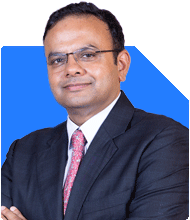Ramalingam Kalirajan |10241 Answers |Ask -Follow
Mutual Funds, Financial Planning Expert - Answered on Apr 27, 2024
He has an MBA in finance from the University of Madras and is a certified financial planner.
He is the director and chief financial planner at Holistic Investment, a Chennai-based firm that offers financial planning and wealth management advice.... more

Hello Sir, I am looking forward to create a corpus of Rs. 1.5 crores in span of 7 years. What will be your suggestion. I have few SIPs less than Rs. 5,000 and very small FDs. There are FDs around Rs. 1 lakhs. How do I build up the corpus?
Review and Optimize SIPs: Evaluate your existing SIPs and consider increasing the contribution amounts if possible. Ensure that your SIPs are invested in diversified mutual funds that align with your risk profile and investment goals. Regularly monitor their performance and make adjustments as needed.
Increase Savings: Look for opportunities to increase your savings rate by cutting down on non-essential expenses and redirecting those funds towards your investment goals. Consider setting up systematic investment plans for larger amounts to accelerate wealth accumulation.
Explore High-Yield Investments: Since your FDs are relatively small, consider exploring higher-yield investment options such as equity mutual funds, which have the potential to generate higher returns over the long term. However, be mindful of the associated risks and ensure your investment strategy aligns with your risk tolerance.
Diversify Your Portfolio: Don't put all your eggs in one basket. Diversify your investment portfolio across different asset classes like equity, debt, and possibly real estate or gold, depending on your risk appetite and investment horizon. This can help mitigate risk and optimize returns.
Seek Professional Advice: Consider consulting with a Certified Financial Planner to tailor a comprehensive financial plan that aligns with your goals and risk tolerance. They can provide personalized guidance, recommend suitable investment strategies, and help you stay on track towards achieving your target corpus.
Remember, achieving financial goals requires discipline, patience, and a long-term perspective. Stay focused on your objectives, regularly review your progress, and make adjustments as necessary to stay on course towards building your desired corpus.
You may like to see similar questions and answers below
Sudhanshu Singh | Answer |Ask -Follow
Answered on Apr 12, 2022
Ulhas Joshi | Answer |Ask -Follow
Mutual Fund Expert - Answered on Apr 11, 2023
Abhishek Dev | Answer |Ask -Follow
Financial Planner - Answered on Aug 02, 2023
Ramalingam Kalirajan |10241 Answers |Ask -Follow
Mutual Funds, Financial Planning Expert - Answered on May 08, 2024
Ramalingam Kalirajan |10241 Answers |Ask -Follow
Mutual Funds, Financial Planning Expert - Answered on May 14, 2024
Dr Dipankar Dutta |1795 Answers |Ask -Follow
Tech Careers and Skill Development Expert - Answered on Aug 14, 2025
Dr Dipankar Dutta |1795 Answers |Ask -Follow
Tech Careers and Skill Development Expert - Answered on Aug 14, 2025
Dr Dipankar Dutta |1795 Answers |Ask -Follow
Tech Careers and Skill Development Expert - Answered on Aug 14, 2025
Dr Dipankar Dutta |1795 Answers |Ask -Follow
Tech Careers and Skill Development Expert - Answered on Aug 14, 2025
Dr Dipankar Dutta |1795 Answers |Ask -Follow
Tech Careers and Skill Development Expert - Answered on Aug 14, 2025
Dr Dipankar Dutta |1795 Answers |Ask -Follow
Tech Careers and Skill Development Expert - Answered on Aug 14, 2025
Dr Dipankar Dutta |1795 Answers |Ask -Follow
Tech Careers and Skill Development Expert - Answered on Aug 14, 2025
Dr Dipankar Dutta |1795 Answers |Ask -Follow
Tech Careers and Skill Development Expert - Answered on Aug 14, 2025
Nayagam P P |10270 Answers |Ask -Follow
Career Counsellor - Answered on Aug 14, 2025
Nayagam P P |10270 Answers |Ask -Follow
Career Counsellor - Answered on Aug 14, 2025























